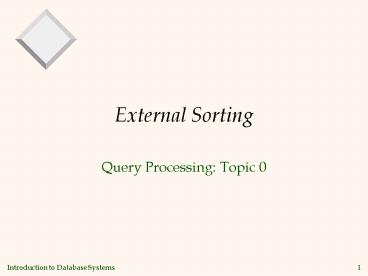External Sorting - PowerPoint PPT Presentation
Title:
External Sorting
Description:
Each pass we read write each page in file. N pages in the file = the number of passes ... of Passes of Optimized Sort. Chunk size = 32, initial pass produces ... – PowerPoint PPT presentation
Number of Views:139
Avg rating:3.0/5.0
Title: External Sorting
1
External Sorting
- Query Processing Topic 0
2
Why Sort?
- A classic problem in computer science!
- Data requested in sorted order
- e.g., find students in increasing age order
- Sorting is first step in bulk loading B tree
index. - Sorting useful for eliminating duplicate copies
in a collection of records (Why?) - Sort-merge join algorithm involves sorting.
- Problem sort 1Gb of data with 32Mb of RAM.
- why not virtual memory?
3
2-Way Sort Requires 3 Buffers
- Pass 1 read a page, sort it, write it.
- only one buffer page is used
- Pass 2, 3, , etc.
- three buffer pages used.
4
2-Way External Merge Sort
Input file
- Each pass we read write each page in file.
- N pages in the file gt the number of passes
- So total cost is
- Idea Divide and conquer sort subfiles and merge
PASS 0
1-page runs
PASS 1
2-page runs
PASS 2
4-page runs
PASS 3
8-page runs
5
General External Merge Sort
- More than 3 buffer pages. How to take advantage?
- To sort a file with N pages using B buffer pages
- Pass 0 use B buffer pages. Produce
sorted runs of B pages each. - Pass 2, , etc. merge B-1 runs.
6
Cost of External Merge Sort
- Number of passes
- Cost 2N ( of passes)
- E.g., with 5 buffer pages, to sort 108 page file
- Pass 0 22 sorted runs of 5
pages each (last run is only 3 pages) - Pass 1 6 sorted runs of 20
pages each (last run is only 8 pages) - Pass 2 2 sorted runs, 80 pages and 28 pages
- Pass 3 Sorted file of 108 pages
7
Number of Passes of External Sort
8
Internal Sort Algorithm
- Quicksort is a fast way to sort in memory
- An alternative is tournament sort (a/k/a
heapsort) - Top Read in B blocks
- Output move smallest record to output buffer
- Read in a new record r
- insert r into heap
- if r not smallest, then GOTO Output
- else remove r from heap
- output heap in order GOTO Top
9
More on Heapsort
- Fact average length of a run in heapsort is 2B
- Worst-Case
- What is min length of a run?
- How does this arise?
- Best-Case
- What is max length of a run?
- How does this arise?
- Quicksort is faster, but...
10
I/O for External Merge Sort
- longer runs often means fewer passes!
- Actually, do I/O a page at a time
- In fact, read a chunk of pages sequentially!
- Suggests we should make each buffer
(input/output) be a chunk of pages. - But this will reduce fan-out during merge passes!
- In practice, most files still sorted in 2-3
passes.
11
Number of Passes of Optimized Sort
- Chunk size 32, initial pass produces runs of
size 2B.
12
Sorting Records!
- Sorting has become a blood sport!
- Parallel sorting is the name of the game...
- Datamation Sort 1M records of size 100bytes
- typical DBMS 15 minutes
- world record ???
- New benchmarks proposed
- Minute Sort how many can you sort in 1 minute?
- Dollar Sort how many can you sort for 1.00?
13
Using B Trees for Sorting
- Scenario table to be sorted has B tree index on
sorting column(s) - Idea Can retrieve records in order by traversing
leaf pages. - Is this a good idea?
- Cases to consider
- B tree is clustered Good idea!
- B tree is not clustered Could be a very bad idea!
14
Summary
- External sorting is important DBMS may dedicate
part of buffer pool for sorting! - External merge sort minimizes disk I/O cost
- Pass 1 produces sorted runs of size B ( buffer
pages). Later passes merge runs. - of runs merged at a time depends on B, and
chunk size. - Larger chunk size means less I/O cost per page.
- Larger chunk size means smaller runs merged.
- In practice, of runs rarely more than 2 or 3.
15
Summary, cont.
- Choice of internal sort algorithm may matter
- quicksort Quick!
- heap/tournament sort slower (2x), longer runs
- The best sorts are wildly fast
- Despite 40 years of research, were still
improving! - Clustered B tree is good for sorting
unclustered tree is usually very bad.































